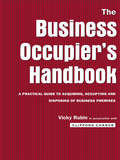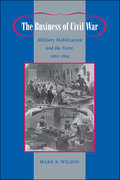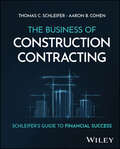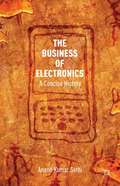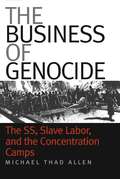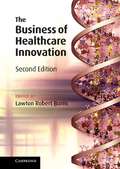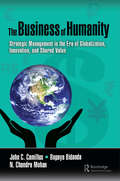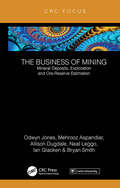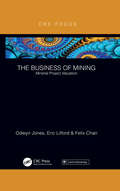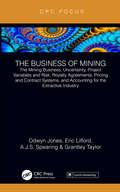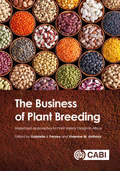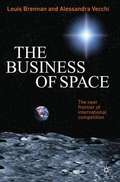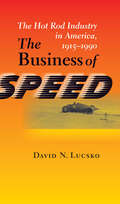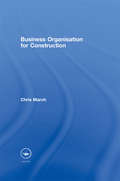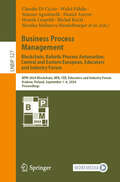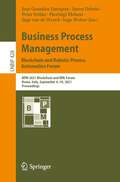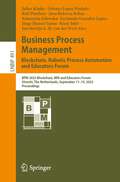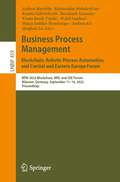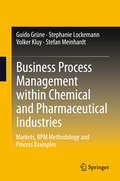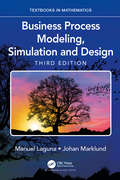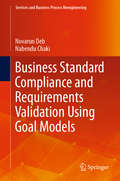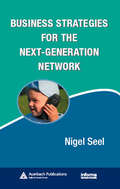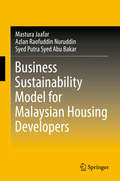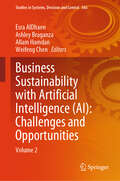- Table View
- List View
The Business Occupier's Handbook: A Practical guide to acquiring, occupying and disposing of business premises
by Clifford Chance Vicky RubinWhatever your type of business, this practical handbook will help you to manage your premises effectively. Whether you are a tenant or an owner-occupier, it will enable you to take an informed approach to commercial property, helping you to negotiate successful transactions, deal with ongoing management issues effectively and get the most from advisers and agents. The handbook takes a practical approach using worked examples and checklists. It provides a step-by-step guide to all the stages of occupation with comprehensive coverage of all the relevant legal and technical information, including: * strategic property management * financial analysis and decision making * negotiating strategy * valuaton * accounting * tax and business rates * acquisitions * purchase and lease terms * rent reviews * service charges * insurance * repairs alterations and use * planning and environmental issues* disposal of surplus space * lease expiries and renewals * compulsory purchase.
The Business of Civil War: Military Mobilization and the State, 1861–1865 (Johns Hopkins Studies in the History of Technology)
by Mark R. WilsonThis wide-ranging, original account of the politics and economics of the giant military supply project in the North reconstructs an important but little-known part of Civil War history. Drawing on new and extensive research in army and business archives, Mark R. Wilson offers a fresh view of the wartime North and the ways in which its economy worked when the Lincoln administration, with unprecedented military effort, moved to suppress the rebellion. This task of equipping and sustaining Union forces fell to career army procurement officers. Largely free from political partisanship or any formal free-market ideology, they created a mixed military economy with a complex contracting system that they pieced together to meet the experience of civil war. Wilson argues that the North owed its victory to these professional military men and their finely tuned relationships with contractors, public officials, and war workers. Wilson also examines the obstacles military bureaucrats faced, many of which illuminated basic problems of modern political economy: the balance between efficiency and equity, the promotion of competition, and the protection of workers' welfare. The struggle over these problems determined the flow of hundreds of millions of dollars; it also redirected American political and economic development by forcing citizens to grapple with difficult questions about the proper relationships among government, business, and labor. Students of the American Civil War will welcome this fresh study of military-industrial production and procurement on the home front—long an obscure topic.
The Business of Construction Contracting: Schleifer's Guide to Financial Success
by Thomas C. Schleifer Aaron B. CohenExplore this deep dive into the business side of construction, including how to structure, organize, and operate a construction organization to maximize profit The most visible work of construction contracting happens on the job site, but some of the most important aspects of running a construction business happen behind the scenes, on the financial and operations side. Construction is the second-most risk-intensive industry in the US, and both minimizing business failures and minimizing the damage that results from inevitable failures are critical. Structuring and managing a profitable construction business requires strategic sense and up-to-date knowledge. The Business of Construction Contracting describes and analyzes the business side of construction, with a detailed exploration of the major types of business failure and how to avoid them. It’s designed for construction professionals who understand that in this industry everybody faces risk exposure, and the companies that survive and thrive are the ones who understand how to recognize the risks and respond accordingly. It offers documented research findings, rooted in years of construction business experience, that can help both new and veteran business owners find success. The Business of Construction Contracting readers will also find: Exploration of the concepts of flexible overhead, corporate, and financial self-analysisDetailed discussion of topics including cash flow thresholds, construction market cycles, and moreThe latest industry technologies and techniques to manage a construction business The Business of Construction Contracting is ideal for construction professionals – including general contractors, construction managers, and specialty contractors – as well as bonding and insurance professionals, construction attorneys, and vendors servicing the construction industry.
The Business of Electronics
by Anand Kumar SethiElectronics is an ever-changing field with an entrepreneurial spirit and a rich history, populated by some of the world's most famous companies and personalities. The Business of Electronics details the field's complex ecosystem in all its trials and tribulations. It looks at companies such as Apple, IBM, Samsung, and Nokia, as well as now-extinct companies such as Honeywell Bull (France) and Sinclair Computers (UK) that contributed to technology and business. Sethi shows us how a handful of US companies led the charge in designing equipment that could make millions of small, reliable components; how Nokia started in the timber business; the history of inventors like J. C. Bose, a pioneer in radio communication (who inadvertently made Guglielmo Marconi famous); and why there are numerous companies and creators that never made it or that we have never heard of. This all-encompassing book not only explores the vibrant history of electronics, it uses case studies to examine the companies and people that made history and explain how we ended up where we are today.
The Business of Genocide
by Michael Thad AllenDuring World War II, hundreds of thousands of prisoners were worked to death by the Nazis under a brutal system of slave labor in the concentration camps. By 1942, this vast network of slavery extended across all of German-occupied Europe, but the whole operation was run by a surprisingly small staff of bureaucrats--no more than 200 engineers and managers who worked in the Business Administration Main Office of the SS. Their projects included designing and constructing the concentration camps and gas chambers, building secret underground weapons factories, and brokering slave laborers to private companies such as Volkswagen and IG Farben. The Business of Genocide powerfully contradicts the assumption that the SS forced slavery upon the German economy, demonstrating that instead industrialists actively sought out the Business Administration Main Office as a valued partner in the war economy. Moreover, while the bureaucrats who oversaw Holocaust operations have often been seen as technocrats or simple "cogs in the machinery," the book reveals their ideological dedication, even fanatical devotion, to slavery and genocide in the name of National Socialism.During World War II, hundreds of thousands of prisoners were worked to death by the Nazis under a brutal system of slave labor in the concentration camps across all of German-occupied Europe. The whole operation was run by a surprisingly small staff of bureaucrats--no more than 200 engineers and managers who worked in the Business Administration Main Office of the SS. Michael Thad Allen powerfully contradicts the assumption that the SS forced slavery upon the German economy, demonstrating that instead industrialists actively sought out the Business Administration Main Office as a valued partner in the war economy. Moreover, while the bureaucrats who oversaw Holocaust operations have often been seen as technocrats or simple "cogs in the machinery," this book reveals their ideological dedication, even fanatical devotion, to slavery and genocide in the name of National Socialism.-->
The Business of Healthcare Innovation
by Lawton Robert BurnsThe Business of Healthcare Innovation is a wide-ranging analysis of business trends in the manufacturing segment of the healthcare industry. It provides a thorough overview and introduction to the innovative sectors fueling improvements in healthcare: pharmaceuticals, biotechnology, platform technology, medical devices and information technology. For each sector, the book examines the basis and trends in scientific innovation, the business and revenue models pursued to commercialize that innovation, the regulatory constraints within which each sector must operate and the growing issues posed by more activist payers and consumers. Specific topics include market structure and competition, the economics and rationale of product development, pricing, sales and marketing, contract negotiations with buyers, alliances versus mergers, business strategies and prospects for growth. Written by professors of the Wharton School and industry executives, the book shows why healthcare sectors are such an important source of growth in any nation's economy.
The Business of Humanity: Strategic Management in the Era of Globalization, Innovation, and Shared Value
by John Camillus Bopaya Bidanda N. Chandra MohanCompanies across the world, for a variety of reasons, are committing to incorporating social responsibility into their business models and finding that their profits are growing and their long-term sustainability is enhanced—building "humanity" into their business models as the driver of economic, environmental, and social sustainability. This fascinating development is a widely observable global phenomenon. The "Business of Humanity®" (BoH) Proposition is the synthesis of counter-intuitive but simple and powerful ideas about how companies can add value in today’s globalized and fast-changing world. The task of BoH Strategies is to overcome three critical challenges characterizing today’s business environment, namely disruptive technologies, conflicted stakeholders, and unknowable futures. BoH Strategies are designed to convert these challenges into opportunities for enhanced sustainability on all three dimensions—economic, environmental and social. Written by leading experts with decades of experience, this book: Provides a hands-on understanding of how to implement this powerful and rewarding approach to simultaneously add economic value and enhance social benefit Includes the experiences and approaches of highly regarded business executives and successful organizations Responds to the critical challenges created by three environmental mega forces – the inevitability of globalization, the imperative of innovation, and the importance of shared value. This book is based on lessons drawn from the real world and provides a compelling rationale for the power of the BoH Proposition. The pragmatic framework and process offered enable companies to develop and confidently implement value-adding strategies based on the BoH Proposition.
The Business of Mining: Mineral Deposits, Exploration and Ore-Reserve Estimation (Volume 3) (The Business of Mining)
by Ifan Odwyn Jones Mehrooz Aspandiar Allison Dugdale Neal Leggo Ian Glacken Bryan SmithThe Business of Mining complete set of three Focus books provides readers with a holistic all-embracing appraisal of the analytical tools available for assessing the economic viability of prospective mines. Each volume has a discrete focus. This third volume commences with "Our Earth, its Minerals and Ore Bodies", followed by a review of mineral exploration and sampling of mineral deposits. It continues with detailed sections covering the reporting of mineral resources and reserves in Australia, and concludes with the basic principles and application of the various methods of estimating the in-situ mineral resources and ore reserves. The books were written primarily for undergraduate applied geologists, mining engineers and extractive metallurgists and those pursuing course-based postgraduate programs in mineral economics. However, the complete series will also be an extremely useful reference text for practicing mining professionals as well as for consultant geologists, mining engineers or primary metallurgists.
The Business of Mining: Mineral Project Valuation (The Business of Mining)
by Odwyn Jones Eric Lilford Felix ChanThe Business of Mining complete set of three Focus books will provide readers with a holistic all-embracing appraisal of the analytical tools available for assessing the economic viability of prospective mines. Each volume has a discrete focus. This second volume discusses, in some depth, alternative means of assessing the economic viability of mining projects based on the best estimate of the recoverable mineral and/or fossil fuel reserves. The books were written primarily for undergraduate applied geologists, mining engineers and extractive metallurgists and those pursuing course-based postgraduate programs in mineral economics. However, the complete series will also be an extremely useful reference text for practicing mining professionals as well as for consultant geologists, mining engineers or primary metallurgists.
The Business of Mining: The Mining Business, Uncertainty, Project Variables and Risk, Royalty Agreements, Pricing and Contract Systems, and Accounting for the Extractive Industry (The Business of Mining)
by Odwyn Jones Eric Lilford Sam Spearing Grantley TaylorThe Business of Mining complete set of three Focus books will provide readers with a holistic all-embracing appraisal of the analytical tools available for assessing the economic viability of prospective mines. Each volume has a discrete focus. This first volume presents an overview of the mining business, followed by an analysis of project variables and risk, an overall coverage of the royalty agreements, pricing and contract systems followed by a final chapter on accounting standards and practises for the minerals industry. The books were written primarily for undergraduate applied geologists, mining engineers and extractive metallurgists and those pursuing course-based postgraduate programs in mineral economics. However, the complete series will also be an extremely useful reference text for practicing mining professionals as well as for consultant geologists, mining engineers or primary metallurgists.
The Business of Plant Breeding
by G. J. Persley V. M. AnthonyThe Business of Plant Breeding is the result of a study on demand-led plant variety design for markets in Africa, sharing best practices from private and public sector breeding programmes worldwide that are applicable to improving tropical crops in Africa. Beginning with an overview of the principles of demand-led plant breeding, the book then discusses aspects such as understanding the demands of clients and markets in rural and urban areas, foresight in setting product profiles and breeding targets, and determining breeding strategy and stage plans. It also covers measuring success and making the business case for future investments in breeding programmes that will deliver new varieties to meet market demands. The book: - Brings together the experience of plant breeders around the world, representing universities, national plant breeding programmes, regional and international agricultural research institutes, and private seed companies, showcasing how to respond to changing market demands; - Provides educational resource materials within each chapter; - Includes templates for use as planning tools by plant breeding programs for determining priority traits that meet market demands. An important read for professionals and students of plant breeding and genetics, this book is also a useful resource for anyone interested in developing and disseminating new, market-led technologies to increase productivity and profitability in tropical agriculture. The study was sponsored by the Australian Centre for International Agricultural Research, the Crawford Fund and the Syngenta Foundation for Sustainable Agriculture, and managed by the University of Queensland.
The business of space
by Louis Brennan Alessandra VecchiThis book looks at the space industry from a business perspective, with a focus on international competition. The space industry traces its origins to the middle of last century as a government/military domain and the author now looks at the ongoing evolution of space exploration and travel, and projects the future of the industry.
The Business of Speed: The Hot Rod Industry in America, 1915–1990 (Johns Hopkins Studies in the History of Technology)
by David N. Lucsko2009 Outstanding Academic Title, ChoiceSince the mass production of Henry Ford’s Model T, car enthusiasts have been redesigning, rebuilding, and reengineering their vehicles for increased speed and technical efficiency. They purchase aftermarket parts, reconstruct engines, and enhance body designs, all in an effort to personalize and improve their vehicles. Why do these car enthusiasts modify their cars and where do they get their aftermarket parts? Here, David N. Lucsko provides the first scholarly history of America’s hot rod business. Lucsko examines the evolution of performance tuning through the lens of the $34-billion speed equipment industry that supports it. As early as 1910, dozens of small shops across the United States designed, manufactured, and sold add-on parts to consumers eager to employ new technologies as they tinkered with their cars. Operating for much of the twentieth century in the shadow of the Big Three automobile manufacturers—General Motors, Ford, and Chrysler—these businesses grew at an impressive rate, supplying young and old hot rodders with thousands of performance-boosting gadgets. Lucsko offers a rich and heretofore untold account of the culture and technology of the high-performance automotive aftermarket in the United States, offering a fresh perspective on the history of the automobile in America.
The Business of Waste
by Raymond G. Stokes Roman Köster Stephen C. Sambrook Raymond G. Stokes Roman KösterThe advent of consumer societies in the United Kingdom and West Germany after 1945 led to the mass 'production' of garbage. This book compares the social, cultural and economic fallout of the growing volume and changing composition of waste in the two countries from 1945 to the present through sustained attention to changes in the business of handling household waste. Though the UK and Germany are similar in population density, degrees of urbanisation, and standardisation, the two countries took profoundly different paths from low-waste to throwaway societies, and more recently, towards the goal of 'zero-waste'. The authors explore evolving balances between public and private provision in waste services; the transformation of public cleansing into waste management; the role of government legislation and regulation; emerging conceptualisations of recycling and resource recovery; and the gradual shift of the industry's regulatory and business context from local to national and then to international.
Business Organisation for Construction
by Chris MarchWith a user-friendly style and a strong theoretical base, Business Organisation for Construction provides readers with the tools required to skillfully and successfully operate a business in today's construction industry. Arranged into three sections, Chris March explains: strategy and vision, business finance and the market place the organization, recruitment, support, motivation and leadership of people communication and negotiation. With a wealth of practical construction industry experience, March provides rich anecdotal evidence to enlighten the theory, as well as illustrations and tables to clarify. Available singly or as part of a set, Business Organisation for Construction is a valuable resource for construction students.
Business Process Management: BPM 2024 Blockchain, RPA, CEE, Educators and Industry Forum, Krakow, Poland, September 1–6, 2024, Proceedings (Lecture Notes in Business Information Processing #527)
by Claudio Di Ciccio Walid Fdhila Simone Agostinelli Daniel Amyot Henrik Leopold Michal Krčál Monika Malinova Mandelburger Gregor Polančič Katarina Tomičić-Pupek Katarzyna Gdowska Thomas Grisold Piotr Sliż Iris Beerepoot Renata Gabryelczyk Ralf PlattfautThis book constitutes the proceedings of the BPM 2024 Blockchain/RPA/CEE/Educators/Industry Forum held at the 22nd International Conference on Business Process Management, BPM 2024, which took place in Krakow, Poland, in September 2024. The Blockchain Forum provided a platform for exploring and discussing innovative ideas on the intersection of BPM and blockchain technology. The CEE Forum deals with BPM research in Central and Eastern European countries, emphasizing the specific challenges due to cultural, political, regional, or organizational differences. The RPA Forum focused on the use of the Robotic Process Automation (RPA) in the field of Business Process Management. The Educators Forum brought together educators within the BPM community for sharing resources to improve the practice of teaching BPM-related topics. The Industry Forum served as a platform connecting academia and industry professionals to exchange real-world experiences and insights on leveraging Business Process Management. The total of 35 papers included in this book was carefully reviewed and selected from a total of 69 papers submitted to these forums.
Business Process Management: BPM 2021 Blockchain and RPA Forum, Rome, Italy, September 6–10, 2021, Proceedings (Lecture Notes in Business Information Processing #428)
by José González Enríquez Søren Debois Peter Fettke Pierluigi Plebani Inge van de Weerd Ingo WeberThis book constitutes the proceedings of the Blockchain and RPA Forum, held as part of the 19th International Conference on Business Process Management, BPM 2021, which took place during September 6-10, 2021, in Rome, Italy.The Blockchain Forum and the RPA Forum have in common that they are centered around an emerging and exciting technology. The blockchain is a sophisticated distributed ledger technology, while RPA software allows for mimicking human, repetitive actions. Each of these have the potential to fundamentally change how business processes are being orchestrated and executed in practice. The 8 papers presented in this volume were carefully reviewed and selected from a total of 14 submissions.
Business Process Management: BPM 2023 Blockchain, RPA and Educators Forum, Utrecht, The Netherlands, September 11–15, 2023, Proceedings (Lecture Notes in Business Information Processing #491)
by Julius Köpke Orlenys López-Pintado Ralf Plattfaut Jana-Rebecca Rehse Katarzyna Gdowska Fernanda Gonzalez-Lopez Jorge Munoz-Gama Koen Smit Jan Martijn E. M. van der WerfThis book constitutes the proceedings of the BPM Forum held at the 21st International Conference on Business Process Management, BPM 2023, which took place in Utrecht, The Netherlands, in September 2023. The Blockchain Forum provided a platform for exploring and discussing innovative ideas on the intersection of BPM and blockchain technology. The RPA Forum focused on the use of the Robotic Process Automation (RPA) in the field of Business Process Management. The Educators Forum brought together educators within the BPM community for sharing resources to improve the practice of teaching BPM-related topics. The 18 full papers included in this volume were carefully reviewed and selected from a total of 39 submissions.
Business Process Management: BPM 2022 Blockchain, RPA, and CEE Forum, Münster, Germany, September 11–16, 2022, Proceedings (Lecture Notes in Business Information Processing #459)
by Andrea Marrella Raimundas Matulevičius Renata Gabryelczyk Bernhard Axmann Vesna Bosilj Vukšić Walid Gaaloul Mojca Indihar Štemberger Andrea Kő Qinghua LuThis book constitutes the proceedings of the Blockchain, Robotic Process Management (RPA), and Central and Eastern Europe (CEE) Forum which were held as part of the 20th International Conference on Business Process Management, BPM 2022, which took place in Münster, Germany, during September 11-15, 2022. The Blockchain Forum is dealing with techniques for and applications of blockchains, distributed ledger technologies, and related topics. "The RPA Forum brings together researchers from various communities to discuss challenges, opportunities, and new ideas related to robotic process automation and its application to business processes in private and public sectors." The CEE Forum provides a discussion platform for BPM academics from Central and Eastern Europe to disseminate their research, compare results and share experiences. The 20 papers presented in this volume were carefully reviewed and selected from a total of 40 submissions.
Business Process Management within Chemical and Pharmaceutical Industries: Markets, BPM Methodology and Process Examples
by Guido Grüne Stephanie Lockemann Volker Kluy Stefan MeinhardtAs business processes are crucial success factors for companies, software-based Business Process Management (BPM) is becoming more and more important. In this area SAP, the market leader for enterprise application software, has already gathered substantial experience. For the characterization, modeling and especially the optimization of business processes, SAP's consultants use their own BPM approach. In addition to their considerable methodological know-how, the consultants' profound knowledge of the industries facilitates the focus on core and business-critical processes. This book examines the current market situation, as well as the specific challenges and trends for the chemical and pharmaceutical industries. It also explains business process management basics and the specific SAP Consulting methodology, before illustrating the use of such methods and procedures with sample industry-specific core business processes. With the help of these examples from the chemical and pharmaceutical industries, SAP Consulting provides methodological guidelines on how Business Process Management can be used in practice to optimize business processes and make adjustments in response to constantly changing economic and environmental factors.
Business Process Modeling, Simulation and Design (Textbooks in Mathematics)
by Manuel Laguna Johan MarklundBusiness Process Modeling, Simulation and Design, Third Edition provides students with a comprehensive coverage of a range of analytical tools used to model, analyze, understand, and ultimately design business processes. The new edition of this very successful textbook includes a wide range of approaches such as graphical flowcharting tools, cycle time and capacity analyses, queuing models, discrete-event simulation, simulation-optimization, and data mining for process analytics. While most textbooks on business process management either focus on the intricacies of computer simulation or managerial aspects of business processes, this textbook does both. It presents the tools to design business processes and management techniques on operating them efficiently. The book focuses on the use of discrete event simulation as the main tool for analyzing, modeling, and designing effective business processes. The integration of graphic user-friendly simulation software enables a systematic approach to create optimal designs.
Business Standard Compliance and Requirements Validation Using Goal Models (Services and Business Process Reengineering)
by Nabendu Chaki Novarun DebThis book discusses enterprise hierarchies, which view a target system with varying degrees of abstraction. These requirement refinement hierarchies can be represented by goal models. It is important to verify that such hierarchies capture the same set of rationales and intentions and are in mutual agreement with the requirements of the system being designed. The book also explores how hierarchies manifest themselves in the real world by undertaking a data mining exercise and observing the interactions within an enterprise. The inherent sequence-agnostic property of goal models prevents requirement analysts from performing compliance checks in this phase as compliance rules are generally embedded with temporal information. The studies discussed here seek to extract finite state models corresponding to goal models with the help of model transformation. The i*ToNuSMV tool implements one such algorithm to perform model checking on i* models. In turn, the AFSR framework provides a new goal model nomenclature that associates semantics with individual goals. It also provides a reconciliation machinery that detects entailment or consistency conflicts within goal models and suggests corrective measures to resolve such conflicts. The authors also discuss how the goal maintenance problem can be mapped to the state-space search problem, and how A* search can be used to identify an optimal goal model configuration that is free from all conflicts. In conclusion, the authors discuss how the proposed research frameworks can be extended and applied in new research directions. The GRL2APK framework presents an initiative to develop mobile applications from goal models using reusable code component repositories.
Business Strategies for the Next-Generation Network (Informa Telecoms And Media Ser.)
by Nigel SeelCarriers and service providers have united around the concept of the Next-Generation Network (NGN). Although leveraging a broad basket of Internet technologies, the NGN is not being planned as the next-generation Internet. In its intention and architecture, it is more accurately described as Broadband-ISDN release 2.0. The NGN transition
Business Sustainability Model for Malaysian Housing Developers
by Mastura Jaafar Azlan Raofuddin Nuruddin Syed Putra Syed Abu BakarThis book presents interviews with 20 successful Malaysian housing developers, to provide real-world insights and practical know-how for future developers. It is designed in a way that reveals the secrets of successful developers, from their origins to their current status with the interviews conducted in a semi-structured manner so that the interviewees were able to freely share their experiences, thoughts, opinions and tips acquired throughout their business careers. Covering the developers' success stories, from their background, educational history and personal traits to their business challenges and achievements, it appeals to academics and practitioners alike.
Business Sustainability with Artificial Intelligence: Volume 2 (Studies in Systems, Decision and Control #566)
by Esra AlDhaen Ashley Braganza Allam Hamdan Weifeng ChenThis book covers different technological and business-related issues including ethical use and cultural sensitivity of data used in businesses, managing data privacy and protection, governance standards for digital transformation, executive leadership strategic decisions, and business innovation and sustainability. With the recent development of artificial intelligence (AI), businesses are urged to consider innovation while applying digital transformation. Depending on the nature of the businesses, it is found that innovative digital transformation is required with the use of artificial intelligence. However, the future of AI in businesses is yet unclear, the question is it true that without digital transformation businesses are no longer sustainable? Researchers argue that digital transformation could be an opportunity for business to create a global brand however several implications and challenges should be considered including governance and responsible digital management. This book explores how businesses could benefit from AI and leverage technologies to sustain businesses. The book is authored by leading experts in the field of AI, digitalization, and business innovation and sustainability; the author’s diversity reflects quality of research with high level of impact in the research topic. It is written in accessible language that makes it easy for business leaders, researchers, policymakers, and anyone interested in the future of business development to understand the complex concepts and ideas presented in the book. This book provides insight for executive leaders in setting new innovative strategies toward leveraging AI in business at different levels of operations to support business sustainability. The book provides different theoretical and practical practices and case studies that could be used as a guideline for policy making and devising innovative directions.
